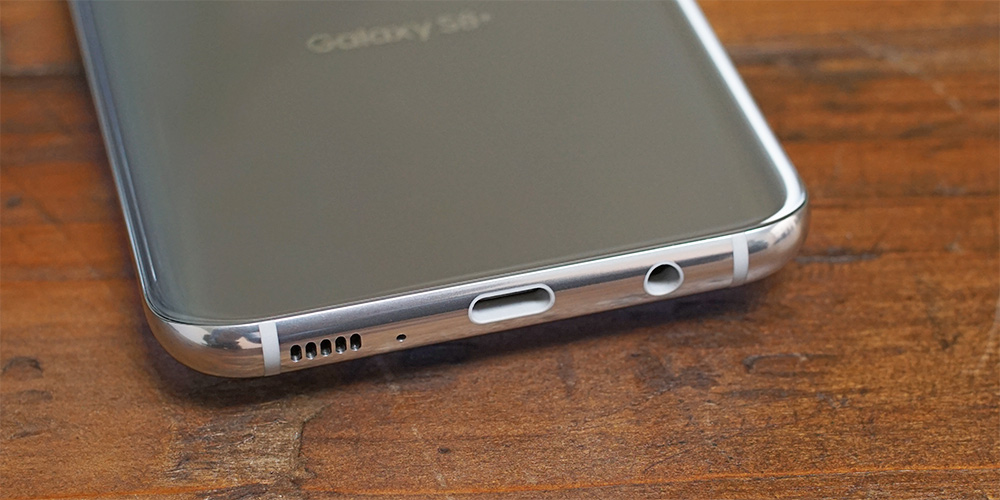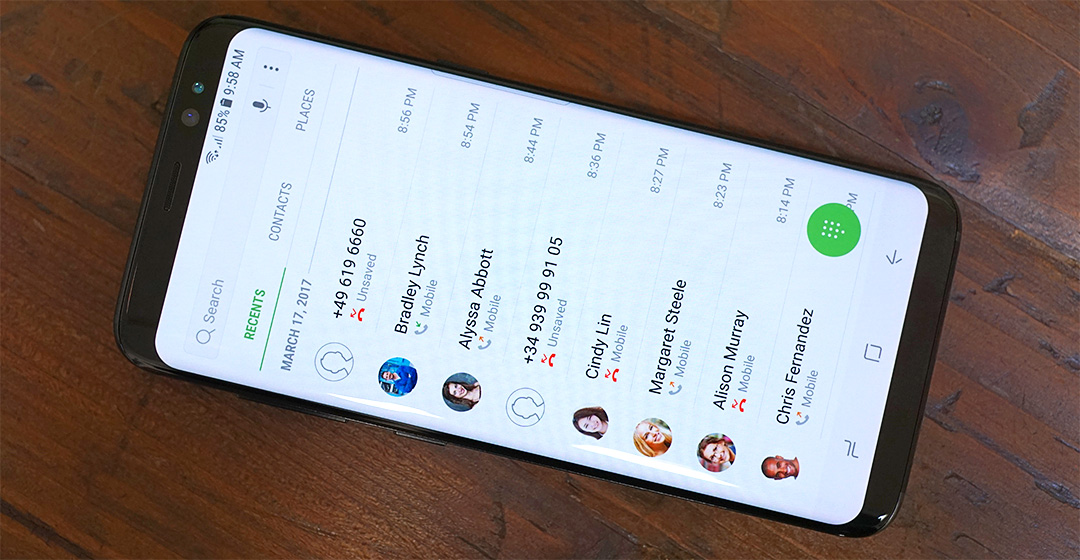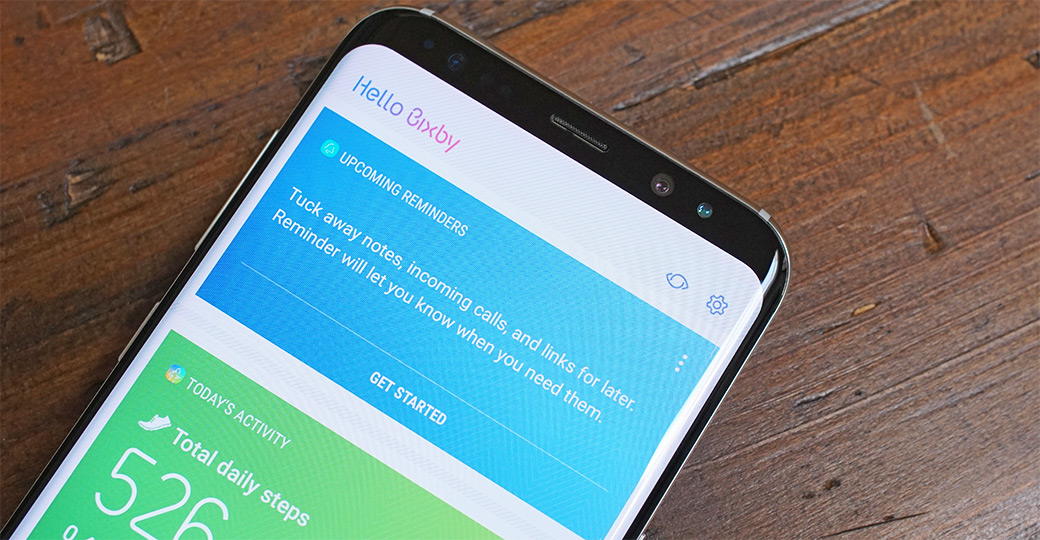Hands On With Samsung's Galaxy S8 and S8+: Taller Screens and Slimmer Bezels
by Matt Humrick on March 29, 2017 11:00 AM EST- Posted in
- Smartphones
- Samsung
- Galaxy
- Mobile
- Galaxy S8

Samsung officially unveiled the latest Galaxy devices at its Unpacked event in New York today. Previous Galaxy phones were part Porsche 911 Carrera, with an easily recognizable curvaceous style, and part Swiss Army knife, bristling with technology and features. This analogy holds true for the 5.8-inch Galaxy S8 and 6.2-inch Galaxy S8+, which share the same design DNA as the previous two generations.
The new phones’ aluminum frame remains sandwiched between edge-to-edge Corning Gorilla Glass 5, with curved sides on the front and back. The curved rear glass makes the phones easier to pick up and more comfortable to hold just as they did for the S7 and S7 edge, while the curved front glass—now standard on both S8 models—adds some visual flair.
There’s not much difference between the S8 and S7 along the sides either. The USB Type-C port on the bottom is flanked by a 3.5mm headphone jack and a single downward-firing speaker. The microSD/NanoSIM combo tray still resides on the top, and the thin power button is still a bit more than halfway up the right side. The only differences between new and old lie on the left side, where the volume buttons have been combined into a single rocker and a dedicated button for launching Samsung’s Bixby assistant makes its debut. Unlike the power button, I found myself occasionally pressing the Bixby button accidentally when picking up the smaller S8.
The most significant change is found up front, however, and it’s one that impacts both form and function. The Galaxy S8 and S8+ adopt Samsung’s new “Infinity Display” that stretches the screen vertically but not horizontally, deviating from the traditional 16:9 aspect ratio. The result is a QHD+ SAMOLED display with a 2960x1440 resolution and an 18.5:9 aspect ratio that’s very similar to the 18:9 aspect ratio display LG is using in its G6. Both Samsung and LG cite market research for this new display direction: People want larger screens that can show more content, but they also want phones that are useable with one hand and can fit in their pocket. The taller screen fits more content, so less scrolling, but keeps the phone narrow, so it’s easier to wrap your hand around.
Both S8 phones incorporate another emerging design trend: rounded display corners. Where LG’s G6 is using an LCD panel that actually has rounded corners, it appears Samsung is using a rounded bezel to cover the S8’s still sharp-cornered display. This avoids the aliasing that’s evident in the G6’s corners, producing a much smoother, nicer looking effect. While my time with the S8 was limited, it appears that TouchWiz and Samsung’s apps were redesigned to account for the rounded corners: Backgrounds extend the full height of the display and visual elements are still displayed along the top and bottom edges without getting cut off. Third-party apps, however, find their vertical dimensions constrained to the purely rectangular portion of the display, with the status bar above and the navigation bar below taking on black backgrounds.
The S8 and S8+ are also the first phones to receive the UHD Alliance’s Mobile HDR Premium certification that ensures a mobile device meets the minimum requirements for playback of 4K HDR video. This means that both S8s are capable of rendering at least 90% of the DCI-P3 color gamut, have a dynamic range of at least 0.0005-540 nits, and support a 10-bit display pipeline.
To keep the overall size of the phones in check, the S8/S8+ and G6 have dramatically reduced the bezel area around the taller screens. Samsung claims a screen-to-body ratio of 83% for its new Galaxy phones, less than the 91.3% of Xiaomi’s Mi MIX concept phone, but impressive nonetheless, especially considering how much hardware is located in the S8’s upper bezel. Besides the usual earpiece and proximity/ambient light sensors, there’s a new 8MP front-facing camera with f/1.7 lens and Smart AF that uses facial recognition for accurate focusing when taking selfies. There’s also an IR LED and IR camera for the iris-scanning security feature that made its debut on the ill-fated Galaxy Note7.
Shrinking the size of the lower bezel required relocating the fingerprint sensor to the back. Instead of placing it below the rear camera like we see on most other phones, Samsung places it next to the flush-mounted camera, which is less than ideal. Both the camera and the sensor are surrounded by a raised lip and are similar in size, making it difficult to locate the sensor by feel, and if your finger misses the sensor, you end up with a nice fingerprint on the camera lens. On the smaller S8, this issue may be mitigated with practice, but the problem is worse for the S8+. Being taller, it places the camera and sensor further from the lower edge, making it very difficult, if not impossible, to reach the sensor when holding the phone with a natural grip. Even with my larger-than-average hands, I struggled to reach the sensor without shifting my grip. I suspect people will turn to the iris scanner or the new face unlock feature, which uses the front camera for facial recognition after pressing the power button, to overcome the poor fingerprint sensor placement. The physical home button and capacitive navigation buttons, iconic Galaxy design features, have also been evicted in favor of the slimmer bezel, replaced by onscreen controls.



















208 Comments
View All Comments
artk2219 - Wednesday, March 29, 2017 - link
Yup, because you were then either replacing a back or a battery, typically not the main unit.PVG - Wednesday, March 29, 2017 - link
Making stuff up to prove a false point, are we?My plastic S3 Mini has fallen countless times, flew apart almost every one of them, allways got back together.
Is on it's 4th battery.
Never had any cases or covers, apart from a screen protecting film and is still in one piece, without even a scratch on the screen.
Is approaching 5 VERY USED years in my hands (or, Everything makers don't want).
I dare anyone to get the same mileage from any of this modern "premium", sealed, resource wasting, pieces of crap.
I know I can't, and will be lucky if my next phone lasts half as much.
Meteor2 - Wednesday, March 29, 2017 - link
My S3 mini was a back-up phone that I hardly used... and expired after two years. The screen just shows random coloured dots.Anecdotes suck.
mkozakewich - Wednesday, March 29, 2017 - link
My Note II died the first week I had it, but the replacement has lasted fine all these years. I don't use it anymore, though, in lieu of a newer $200 phone.My glass-and-metal Surface Pro (1st gen), meanwhile, is still serving me fine as a home computer. So, again, anecdotes.
Notmyusualid - Friday, March 31, 2017 - link
@ PVGRespect to anyone that can get such usage out of your devices, if it suits your needs.
I only changed my GS5, because I needed dual-sim (tired to carrying around two phones). But I've a feeling I'd still be using it, had that not been the case.
Solandri - Wednesday, March 29, 2017 - link
A dropped phone has the same energy whether it's designed to come apart or not. If your phone is not designed to come apart and you drop it, that extra energy which would've gone into bending retaining clips and flinging the pieces apart, instead goes directly into the phone's components. So the single-piece phone actually suffers more internal damage from an equivalent drop than a phone designed to come apart.rabidpeach - Wednesday, March 29, 2017 - link
if you can't put a battery in a phone, perhaps you are too stupid to wield the awesome power contained there-in. so yes it would be great if this bastard with moar money than brains was excluded from our mobile society.bcronce - Wednesday, March 29, 2017 - link
Gorilla glass is incredibly flexible. If you separate the glass from the frame, you can get about a third of the way to having the two ends touch. iPhone uses a "liquid" metal frame that is a modern alloy that is very strong and flexible. Requires a great deal of distortion before it permanently deforms or suffers catastrophic failure.We're not quite there, but if you want slim, you have to give up being able to open it up.
Jon Tseng - Wednesday, March 29, 2017 - link
1) I'd need to check with Corning but pretty sure gorilla isn't that flexible. Were you thinking of Willow Glass?2) No the iPhone frame is not liquudmetal. It is aluminium, although there is some speculation about stainless steel in the 8. AFAIK liquudmetal has only ever been used by Apple in the SIM ejection tool.
mkozakewich - Wednesday, March 29, 2017 - link
It's pretty flexible. I had the glass on one of my devices get shoved out at one corner, and the glass was curving up by a tremendous amount. Luckily, there was no damage and I got it back into place.